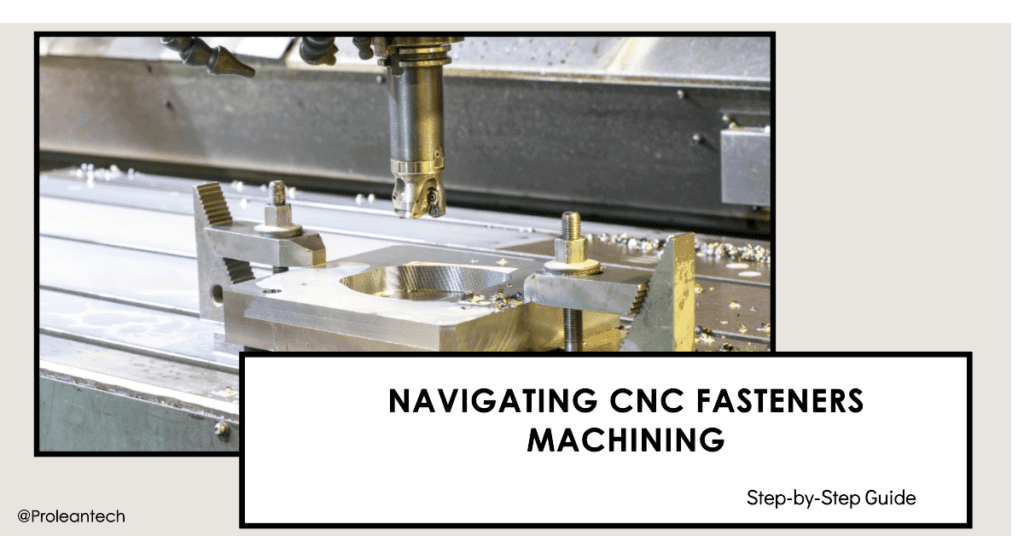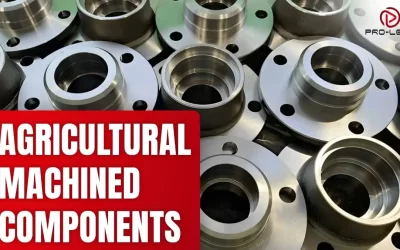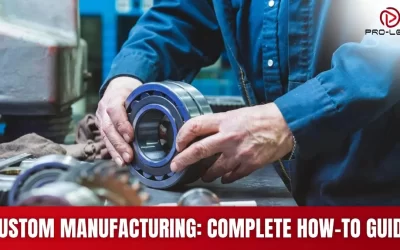
The ever-evolving landscape of manufacturing is a complex labyrinth of precision-driven processes, strategic calculations, and the relentless pursuit of efficiency and quality. Within this realm, an unassuming yet pivotal component – the fastener, plays an indispensable role. Whether it’s to hold the components of an automobile together or secure parts of a spaceship, fasteners are integral to the integrity and safety of countless products.
In this context, CNC fastener machining emerges as an essential process in modern manufacturing. This process involves programming a CNC machine to manufacture fasteners to exact specifications, ensuring unparalleled precision and consistency. In this article, we delve into the specifics of CNC fastener machining, providing a comprehensive step-by-step guide to this essential manufacturing process.
Step 1: Designing the Fastener
Every fastener begins its journey in the realm of design. The process commences with the conceptualization of the fastener’s form based on its intended use and the stresses it will endure. Engineers harness the power of Computer-Aided Design (CAD) software to generate a precise 3D model of the fastener, specifying attributes such as shape, size, threading, and material.
For instance, a fastener destined for the automotive industry may need to withstand substantial vibration and stress, dictating a robust design and choice of material. Conversely, a fastener for a computer motherboard might require finesse and intricate threading, but not the same level of stress resistance.
An overview of the design parameters for a typical fastener is given below:
Table 1: Fastener Design Parameters
| Parameter | Description |
|---|---|
| Shape | Fasteners come in various shapes (bolts, screws, rivets, etc.) determined by their functionality and integration into the larger assembly. |
| Size | The size of the fastener directly corresponds to its intended use. Larger fasteners typically offer increased strength and are used in heavy-duty applications, while smaller fasteners are used in applications requiring finesse. |
| Threading | Fasteners can feature coarse or fine threading. Coarse threads are typically more robust and resist stripping, while fine threads offer better engagement in thin-walled or hard materials. |
| Material | The material choice hinges on the required strength and durability of the fastener. Common materials range from various grades of steel and aluminum to more exotic alloys and ceramics for specialized applications. |
Step 2: Preparing the CNC Machine
Upon completion of the fastener’s design, the next step in the process involves the preparation of the CNC machine for the machining operation. CNC machines function through the precise manipulation of cutting tools by software, adhering to the preset specifications.
To prepare the CNC machine, operators have to select the appropriate cutting tools required for the job, considering factors such as the material of the fastener, the complexity of its design, and the desired finish. The tools range from drills and taps for creating holes and threads to end mills for shaping the fastener.
Once the tools are selected, the machine’s parameters, such as the spindle speed, feed rate, and tool paths, are set based on the requirements of the machining operation. Then, the operator loads the design program (usually in G-code format) into the machine’s control unit.
A summary of the preparation steps for a CNC machine is as follows:
Table 2: Steps to Prepare a CNC Machine
| Step | Description |
|---|---|
| Tool Selection | The operator selects the appropriate cutting tools based on the fastener’s design and material. |
| Setting Parameters | The spindle speed, feed rate, and tool paths are set according to the machining requirements. |
| Loading Program | The design program, often in G-code format, is loaded into the machine’s control unit. This program dictates the machine’s actions in creating the fastener. |
The successful completion of these initial steps sets the stage for the material to be machined, bringing us to the exciting phase where the fastener begins to take shape – the machining process.
Step 3: Machining the Fastener
Now that the design is finalized, and the CNC machine is set up and calibrated, the manufacturing process can begin. In this step, the CNC machine translates the CAD model into a physical object. The raw material is loaded into the CNC machine, and the machine’s cutting tools get to work, carving the fastener out of the material based on the tool paths defined in the G-code.
For example, if the fastener being produced is a bolt, the CNC machine might first use an end mill to shape the bolt’s body and head. Next, a drill could create a hole down the center of the bolt if it’s needed. Finally, a tap would cut threads into this hole.
Here’s a bulleted list summarizing the steps involved in machining a fastener:
- Load the raw material into the CNC machine.
- The machine carves the basic shape of the fastener from the raw material.
- Additional features, such as holes or threads, are added with different tools as required.
- The CNC machine follows the tool paths outlined in the G-code to achieve the desired shape and finish.
Step 4: Quality Control and Finishing
Quality control is an essential aspect of any manufacturing process, and fastener production is no exception. After the machining process is complete, each fastener is inspected to ensure it meets the exact specifications outlined in the design stage.
This could involve measuring the fastener’s dimensions, checking its threads with a gauge, or even stress-testing it to make sure it can stand up to its intended use. Any fasteners that don’t pass these rigorous quality control checks are discarded.
Once a fastener passes the quality control stage, it might undergo additional finishing processes. This could include heat treatments to improve durability, coatings to prevent corrosion, or surface finishing processes to enhance its appearance or texture.
A quick summary of the quality control and finishing stages is as follows:
Table 3: Quality Control and Finishing
| Stage | Description |
|---|---|
| Quality Control | Each fastener is inspected to ensure it meets the design specifications. This may involve various testing methods, including dimensional checks, thread gauging, and stress tests. |
| Finishing Processes | Fasteners may undergo additional processes to improve their performance or appearance, such as heat treatments, anti-corrosion coatings, or surface finishing. |
Step 5: Packaging and Delivery
The final stage of the CNC machining process is packaging and delivery. This process requires just as much precision and attention to detail as the rest of the manufacturing process. Improper packaging could lead to damaged fasteners, reducing their effectiveness and resulting in financial loss.
The fasteners are often packed in a way that prevents them from moving around in their packaging, which can cause scratches or other damage. They may be wrapped in a protective material or placed in separate compartments within the packaging. Special care is taken with fasteners that have been treated with a surface coating, as these can be more susceptible to damage.
Here’s a simplified look at the packaging and delivery process:
- Fasteners are cleaned and prepared for packaging.
- They are then carefully packed to avoid any possible damage during transport.
- The packages are labeled and prepared for shipping.
- They are then shipped to the customer or to a distribution center.
Table 4: Packaging and Delivery
| Stage | Description |
|---|---|
| Cleaning and Preparation | Fasteners are cleaned and prepared for packaging to remove any residues from the manufacturing and finishing processes. |
| Packaging | Fasteners are carefully packed to protect them from damage during transportation. The packaging process varies depending on the type and size of the fasteners and may include the use of protective materials or individual compartments. |
| Shipping | The packed fasteners are labeled and shipped to the customer or a distribution center. |
Read More:
- Criteria for Selecting the Right CAM Software for Your Business
- Decoding M-Code: Real-World Examples for Different CNC Operations
- Common Defects in the Laser Cutting Process
- Common Defects in Sheet Metal Splitting: Causes and Solutions
- The Ultimate Guide to Arc Vs. Gas Welding: Which Technique Reigns Supreme?
- Exploring the Science Behind Solid State Welding: Techniques, Benefits, and Industry Impact
- Gas Welding: A Comprehensive Guide to the Process, Techniques, and Applications
Conclusion
Fasteners may be small components, but their importance in holding together complex assemblies cannot be overstated. The process of manufacturing these essential components with CNC machining is a precise, intricate process, but the end result is a product that performs its function reliably and efficiently. Whether it’s securing parts of an automobile, an aircraft, or a household appliance, CNC-machined fasteners play a critical role in our everyday lives.
Prolean’s CNC Machining Services exemplify this precision and quality, producing fasteners that meet the exacting requirements of diverse industries. No matter what your fastener needs are, you can trust that our CNC Machining Services will deliver.
FAQs
What is CNC machining?
CNC machining is a manufacturing process where pre-programmed computer software controls the movement of factory machinery and tools. The process can be used to control a variety of complex machinery, including grinders, lathes, mills, and routers.
Why is CNC machining used in the manufacture of fasteners?
CNC machining offers high precision, consistency, and versatility, making it ideal for manufacturing fasteners. The ability to accurately reproduce designs and quickly adjust production parameters makes CNC machining a cost-effective choice for both high-volume and custom fastener production.
What types of fasteners can be made using CNC machining?
Almost any type of fastener can be produced using CNC machining, including bolts, screws, nuts, rivets, pins, and more. The design flexibility of CNC machining makes it possible to produce fasteners in a wide range of shapes, sizes, and materials.
What materials can be used in CNC machining of fasteners?
CNC machines can work with a broad range of materials, including metals such as steel, aluminum, and brass, as well as plastics, ceramics, and composites. The choice of material depends on the intended application of the fastener and its required properties.
What is the role of quality control in fastener manufacturing?
Quality control is crucial in fastener manufacturing to ensure that every fastener produced meets the exact design specifications and can perform its intended function effectively. This involves rigorous testing and inspection of the fasteners after production.




Can you Machine Plastic Fasteners??
Yes, We can machine ABS, Nylon, PEEK, etc to make the custom fasteners.